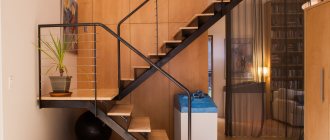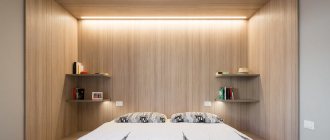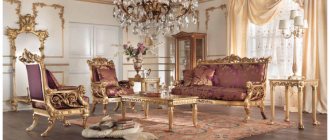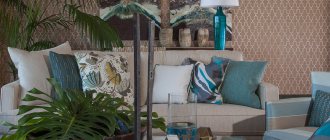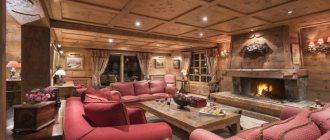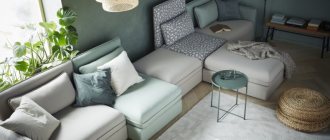Choosing a classic style for the living room interior is a decision that cannot be regretted, because discreet and cozy classics will not become outdated and will not lose their charm over time. But how to create the perfect interior and not make mistakes? What colors should I use? How to properly zone space? Everything you need to know about a living room in a classic style is in our article.
Features of the classic style
There are interior design styles that are rapidly gaining popularity or have already gone out of fashion, and there is a design that will never become outdated or lose its relevance. The classic living room is a unique and universal concept that involves creating a luxurious, elegant and cozy interior that demonstrates the respectability of the owner.
Moreover, unlike pompous baroque with flashy gilding or art deco with complex curved geometric elements, the classical style is quite restrained and carefully simple, without becoming boring or losing its attractiveness over time.
Creating a living room in a classic style will require ideal taste and subtle calculations, because, unlike many modern design options, the classic does not forgive negligence and mistakes in execution. It is not for nothing that the word “classic” itself is of Latin origin and is translated as “delightful” or “ideal.”
Complicating the task is the need to place, combine in color, materials and texture many elements necessary to create a classic living room. You can discard one or more, but without using most of them it is impossible to create a reference design:
- Fireplace with a portal and live or artificial fire;
- Furniture made of natural wood or veneer;
- Molded parts - ceiling rosettes, cornices, baseboards, columns;
- Accessories - paintings, candlesticks, figurines, vases and mirrors;
- Lighting details as a decorative element - chandeliers, sconces, floor lamps;
- Natural materials with rich texture - fabrics, wood, stone.
Symmetry and organic arrangement of furniture, strict lines and discreet patterns, exquisite details and perfect composition - these are the basic rules for organizing a classic space.
Common features of the classics
The style direction is characterized by the presence of expensive and luxurious decorative elements. The style is divided into several types depending on the individual characteristics of each country, so there are many different solutions on the market to suit every taste.
With the help of a classic style, you can highlight the luxury of the living room in any home and create a cozy atmosphere in it.
Living rooms in a classic style always remain fashionable and stylish. In this case, certain design rules must be observed so as not to violate basic traditions. Otherwise, you will not be able to achieve the desired effect. This solution is not cheap, so you should think carefully about your budget.
A living room decorated in a classic style requires a large number of distinct accents.
A characteristic feature of classic design is the use of luxury elements. At the same time, they should look natural, without causing discomfort or heaviness. Among the decorative elements, the following details stand out:
- handmade stucco elements on ceilings and walls;
- a real fireplace - in some cases it is acceptable to replace it with artificial analogues that run on electricity, creating the effect of burning logs;
- the presence of columns and arched openings;
- furniture made of natural wood, which looks massive, but does not create the impression of heaviness;
- the use of heavy natural cornices for curtains and drapes;
- predominant use of natural materials for furniture and room decoration;
- installation of sculptures made of plaster or other natural stones;
- the use of luxurious interior items - expensive crystal vases, candlesticks and other elements;
- canopies, antique paintings, crystal or glass chandeliers, elegant expensive mirrors in frames.
Strict traditional classics are characterized by consistency of one color scheme, textures, and shades.
A classic living room is characterized by a clear distribution of space and the allocation of individual areas. This allows you to leave free areas for movement without creating a feeling of heaviness. The room should be spacious and comfortable.
In such an interior there are no contradictions or sharp transitions; the zoning of the room should be done with smooth and elegant lines and shapes.
Note! You cannot pile up decorative elements without a certain order. Otherwise, all the charm of the classics will be lost. It is important to follow certain rules when arranging furniture and decorative elements. Then you will achieve the desired result.
The classic style assumes the following distribution of free space:
- highlighting a central area with a large soft sofa and a small coffee table;
- separate areas with tables and chairs for guests to relax;
- an area near the fireplace where you can sit in an armchair - you can also put a table for drinks;
- shelves with books and a reading area;
- place for artificial lighting devices.
For finishing, furnishing and decoration, materials such as wood, stone, metal, and high-quality natural fabrics are suitable.
The above is the general layout. It depends on the dimensions of the room and the individual preferences of the owners.
Colors: white living room, beige, gray
The constant constancy of the classic style is also ensured by the win-win combinations of shades in its execution. There cannot be any flashy, dissonant or unnatural combinations of colors in such a living room by default.
The choice of palette for a classic interior depends on the size of the room and the level of illumination in it and is based on the soft contrast of light and dark pastel shades.
Important! If the room is not very large, then you should choose a light background with relatively dark furniture and accents, and a large, open space will allow you to use thick dark shades on the floors and walls, diluted with light furniture and textiles.
The most popular color combinations to bring this style to life:
- Beige-chocolate palette with different shades of cream, sand and khaki;
- Beige-green palette with chocolate, mustard and pistachio shades;
- A blue and white palette with various shades of ivory and blue;
- Sand and burgundy palette with chocolate or pink shades;
- White and gray palette with caramel and cream shades.
You can use more colors, but they should all be soft, natural pastel tones. Professional designers can successfully complement such an interior with bright accessories, but just a few incorrectly selected details can completely destroy the restrained harmony of the classics.
Decoration of a classic hall
The choice of finishing materials for a living room in a classic style depends on the class of design: for elegant rooms in white with gold, appropriate luxurious natural coverings are chosen, and for a restrained interior, a more economical option is also suitable - modern, beautiful solutions, but in a more affordable category of alternative proposals.
- For the floor, parquet or natural stone - marble or granite is considered optimal . Obviously, the rock has a significant mass, so it is used only in private houses and buildings in which such a load has been calculated in advance. A modern alternative is premium laminate and porcelain tiles for a living room of any size. Such materials offer a fairly wide range of colors and textures, so you can always choose harmonious solutions.
- The ceiling in the living room in classicism is usually made white . Traditionally, it is decorated with stucco - around the central chandelier and in the corners of the room. Today, a more practical option is a suspended ceiling, which can be single-level or included in plasterboard structures. Multi-level structures themselves look elegant, so they are not decorated with stucco or its number is reduced to one socket near the lamp.
The photo shows plasterboard ceilings in the living room in a classic style.
- Wall decoration can be varied . Such living rooms can be plastered, painted or wallpapered. This design uses both plain and ornamental coverings. Most often, high-quality wallpaper with a large pattern, called “Damascus,” is chosen. It is characterized by ornate patterns with floral or abstract motifs. Coverings can have a textile outer layer, reminiscent of velvet, satin, or satin in texture.
Repairing such a living room is rarely done with your own hands - it is better to entrust expensive materials to craftsmen in order to eliminate even the minimal risk of damaging the coating.
Living room in a classic style: modern interior design
Just a few decades ago, a classic interior could only be created from expensive natural materials - precious wood, natural stone, silk, velvet, and so on. Today, a variety of finishing materials allows you to successfully imitate wooden, plaster and stone surfaces and avoid enormous costs .
However, fine imitation and crude counterfeiting are not the same thing, so the quality of artificial materials should be met with no less demands than with natural ones.
When choosing a coating, you should follow several immutable rules in order to maintain the chosen style and not disturb the overall composition.
Features of finishing classic living rooms
Expensive marble, oak parquet, textured plaster with a noble pearlescent sheen, natural wood panels, patinated stucco molding - premium materials are used in the decoration of classic living rooms, emphasizing the luxury and sophistication of the interior. The finishing, as a rule, is maintained in the same color scheme, and accents are placed using decor, textiles and lighting.
Wooden panels
All photos In the photo: TV zone in the interior of a living room in a classic style in the “La PROMENADE” community center.
Oak panels in the interior of a living room in a classic style can be used both for wall decoration and for decorating the TV zone. Thanks to the patinated carved decor, they look very impressive and fit organically into the design.
Venetian plaster
All photos In the photo: Classic living room with columns, decorated with Venetian plaster
Venetian plaster with a slight pearlescent sheen can create an aristocratic atmosphere in the living room. In addition, it is a truly universal material, as it is suitable not only for finishing walls and ceilings, but also for decorating large architectural elements with complex geometry: columns, arches, portals.
Oak parquet
All photos In the photo: Aristocratic living room in a classic style in Serebryany Bor
Oak parquet is a traditional flooring for classic interiors. Beautiful and durable, it goes well with any finishing materials. For a strict English living room, it is better to choose dark parquet, and for a neoclassical one, light parquet.
Imitation of boiserie panels
All photos In the photo: Sofa area in the interior of a bright classic living room in a three-room apartment
Imitation of boiserie panels using stucco moldings and silver wallpaper with a classic pattern is an excellent decorative solution for the living room of a city apartment in light colors. Such “panels” look as impressive as wooden ones, but do not increase the load on the walls of the room.
Marble
All photos In the photo: Classic living room with marble floor on the first floor of a house in St. Petersburg
Marble is synonymous with luxury, so it is not surprising that it is often used to decorate classic interiors, decorating walls, stairs, and portals with it. And for the living room of a country house, a light marble floor with a carved stone pattern is perfect.
Wallpaper with damask pattern
All photos In the photo: Spacious living room in a classic style with silver wallpaper
Light wallpaper with a silver damask pattern is a unique finishing material. They always look noble, are suitable for decorating any premises in a classic style and go perfectly with stucco decor and marble.
Walls
The walls of a classic living room can be either a neutral and unobtrusive background or a decorative element. This style allows you to create compositions on the walls from stucco moldings, wooden or fabric panels, use wallpaper with prints and plain ones at the same time, and create an unusual texture using decorative plasters. However, you should use such artistic techniques carefully so as not to oversaturate the interior with details - the use of complex wall decoration implies restraint in furniture and textiles .
Wall decoration
Decorative plaster, wooden panels, and fabric upholstery are used for walls.
If your choice is fabric, then choose golden shades and beige. Subtle, symmetrical patterns will ideally fit the characteristics of the style.
The same applies to the color scheme of classic curtains for the living room.
When choosing wallpaper, prefer vertical patterns. Brightness and excessive flashiness will be inappropriate in this style.
Solid colors and flesh-colored patterns are the favorites of this style.
Ceiling
Unlike the Baroque style, the classic ceiling does not require special attention - neither painting nor gilded elements. However, if the ceiling height is sufficient, you can use plain stucco molding - ceiling roses, baseboards and moldings . If the living room is in an apartment with a standard ceiling height, it is better to avoid the use of heavy elements, leaving a flat, uniform surface. In some cases, it is possible to use a glossy texture to visually increase its height.
Selection of finishing materials
A classic living room will not tolerate cheap decoration (even though it plays the role of a background for the main thing - furniture and accessories). Before deciding on the classics, it is recommended to study the building materials market. The living room will require those that at least look expensive. Some manufacturers are able to produce a “presentable” product at an affordable price.
Floor covering
Finishing the floor of a classic living room has three important features:
- does not play a decisive aesthetic role;
- may be heterogeneous (in modern classics it is permissible for floor textures to differ in different zones);
- Practicality is an absolute requirement. Thin cheap linoleum is categorically excluded.
The basis for arranging a living room in a classic style is made up of expensive, high-quality materials.
Preference:
- laminate with imitation of natural wood, parquet, stone;
- ceramic tiles of restrained colors;
- wooden boards;
- block and piece parquet.
Wall decoration
All finishing comes down to good quality, not devoid of grace. Again and again it is appropriate to recall the naturalness of the ancient style (with which the classical style is closely related). He is both sublime and practical at the same time. This design vector is more than typical of the classics.
- high-quality thick wallpaper;
- whitewashing, including contrasting shades;
- frame fragments edging with molding are welcome. Different textures and tones. Sometimes - plain in an ensemble with figured colors, sometimes painted in an ensemble with wallpaper or pasted fabric;
- It is permissible to cover the walls with panels made of wood or plastic with wood imitation.
The design should not be flashy, colorful, or too small. Large prints and calm natural tones are a priority. Floral ornaments and patterns from the Empire style are acceptable (with care, without going beyond the classical style).
Ceiling finishing
Before talking about finishing, you should remember their height. They must certainly be tall. However, in the absence of height (some typical apartments do not have it), the ceiling is stylized according to classical characteristics. The proportions and lines characteristic of the style are what will help bring the classics to life.
A prerequisite is that the ceilings must be high
- perfectly smooth whitewash with large stucco around the edges and narrow moldings;
- suspended ceilings, most often multi-level;
- plasterboard parts at the second level, less often - the entire ceiling made of plasterboard;
- colors are mainly white and light natural shades;
- matte, gloss, satin are equally acceptable.
Basic requirements for materials and shape of doors and windows
Doors and windows of classic living rooms do not initially require complex shapes. Basically, the openings have a strict geometry without rounded arches (although they may be present if framed by a discreet frame).
Doorways are often without complex shapes and decorations
Special requirements apply to materials:
- natural wood is in the lead - solid wood;
- modern versions of the finish allow the use of high-quality plastic.
Economy-class veneered elements are categorically unsuitable for classic design. Doors and windows are one of the most significant expense items. An important touch is color. Either frankly white (painting), or brown, beige solutions with a clear declaration of wood texture.
You may also be interested in the features of decorating a living room in the English style:
Classic style living room furniture
The first image that appears when you hear the phrase “classic interior” is wooden, heavy cabinet furniture in dark or natural shades, armchairs and sofas with colored fabric upholstery and carved armrests, elegant banquettes, poufs and tables.
All elements must be combined with each other, both in shape and shades, and the arrangement of furniture in the living room must obey the principles of zoning and symmetry. The use of abstract or irregularly shaped furniture such as triangular tables or asymmetrical shelves is strictly unacceptable.
In addition to wooden furniture, it is allowed to use forging, glass tabletops without metal chrome parts, stone decorative elements and fireplace portals.
Furniture and accessories for the living room in classic style
If you look at the photo of a living room in a classic style, you will notice that the furniture looks beautiful and elegant. All furniture is made from expensive and high-quality materials. In modern design, the use of lighter materials is allowed. Among the design elements you can use the following:
- Rich crystal chandeliers, decorated with Bohemian wrought iron elements and glass inserts.
- Using one color scheme for decorative elements - clocks, floor lamps, sconces, glasses. This gives the room aristocracy and grace.
- Installation of furniture made from natural materials with carvings.
- Fireplace decorated with stucco elements and columns.
- Antique paintings.
- Installation of lamps in walls.
- The use of arched structural elements.
Often the accent of the guest area is two linear sofas with leather upholstery and a pair of identical armchairs surrounding a massive coffee table.
When decorating a living room in a classic style, you can use a variety of options. The main thing is the absence of excesses. Strictness, simplicity and grace must be observed in everything. Use lighting to properly highlight corner areas and visually enlarge the space.
Curtains for the living room in a classic style
Textiles are one of the main components that create the atmosphere of a classic interior. Professional designers use complex draperies made of heavy natural fabrics, lambrequins, tiebacks and tassels in combination with weightless tulle to decorate windows, creating a real work of art from curtains.
With the help of curtains, you can decorate absolutely any space - like a window in an apartment with low ceilings, a sunny bay window of a complex shape, or panoramic windows of a modern penthouse. Window textiles are another way to change the geometry of space .
You can visually raise the ceiling with the help of flowing vertical folds on the curtains or soften the sharp corners of the bay window with lambrequin waves - in the hands of a master, an ordinary curtain becomes a professional tool and the main decoration of the living room.
The main rule when decorating a window in a classic interior remains the same - maintaining symmetry and using pastel shades. In this case, you can use a wide variety of fabrics - plain and patterned, heavy and light, natural and artificial. Caution should only be exercised in the texture of the material, because the classic design involves matte surfaces without shiny lurex or organza sparkling in the sun.
Interior design rules
When decorating a living room in a modern classic style, you should follow the following rules:
- furniture is selected that is practical and contains elements of traditional designs. Sliding wardrobes, transforming sofas, and modular walls look good here. Classicism in such furniture items is added with the help of fittings, carvings and the presence of panels;
- the furniture is arranged in pairs: two armchairs, two tables, several banquettes. The main emphasis in decorating the living room is on the symmetrical arrangement of furniture. A fireplace is installed in the center of the room. It can be electric or classic brick;
- ceilings in classical directions are made snow-white and... Paint, decorative plaster, wallpaper, and stretch fabrics are used here. Two-level designs with stucco and frescoes are relevant. The chandeliers chosen are massive crystal ones with crystal pendants. Along with them, wall sconces and floor lamps are installed;
- the walls are decorated with moldings, half-columns, and pilasters. The walls covered with wooden panels look original. When choosing wallpaper, preference is given to discreet materials with low-contrast patterns;
- well thought out lighting. There should be a lot of light in classic interiors. Large window openings, transparent partitions, and large full-length mirrors are welcome here.
Star Half Empty ATTENTION : You can highlight certain local areas in the living room using zigzags, horizontal or vertical stripes on the walls.
Interior design in the style of modern classics, see this video.
The traditional design of a classic apartment in a modern style looks like this: the walls are painted in a neutral and light background, and there are moldings on them. Upholstered furniture is chosen in beige tones, tables and carpets are decorated with geometric prints. The wooden furniture has a pleasant brown color, and the floors are made of parquet.
Living room in classic style with fireplace
The fireplace is rightfully considered the heart of a classic living room. And today the range and quality of electric fireplaces is so extensive that installing a fireplace in an ordinary apartment does not pose any problem.
The most important thing in the interior layout is to correctly determine the place for the future hearth, because it will become the center of the furniture group and should be clearly visible from anywhere in the living room. When placing a fireplace in a dark room with windows facing north, you can decorate the walls framing it with mirrors, expanding the space and filling it with light.
The design of the fireplace portal also plays an important role in the design. Most often, carved wood, brick, stone or their imitations are used to create a frame. The portal should be in harmony with the rest of the interior and echo the furniture, stucco molding and other decorative elements of the room.
also be used to zone the space - for example, mount it in a column separating the dining area from the living room area with sofas and armchairs.
Don’t forget about fireplace accessories - even if an electric version of the hearth is installed, forged fireplace tools and grates will add comfort and individuality, bringing the illusion of a real fire to perfection.
Classic interior lighting
When creating a living room interior in a classic style, you should adhere to moderation. Each corner should have its own chandelier or other selected lighting system. This is one of the main requirements that must be met in order to achieve the desired result. For this reason, large rooms are always decorated in a classic style. Small-sized options are possible. Then, with the help of lamps, you can visually expand the space, make the atmosphere warmer and more homely.
An important part of the interior of a living room in a traditional style is the presence of a large number of lighting sources.
It is not recommended to save money when arranging a lighting system. Not only the quality of the style, but also the impression of being in the room depends on this. The following elements must be present:
- installation of large and massive chandeliers made of crystal and other brands of crystal - decoration from forged elements, openwork metal, expensive ceramics or faience is welcome;
- the use of floor lamps, sconces, floor lamps to highlight individual zones;
- installation of symmetrical lamps on different surfaces - in this case, you should choose the same products to achieve the desired effect.
The chandelier should have an antique design, and it is better to choose sconces with forged metal elements.
Classic is a style that requires a large number of lighting elements. Natural light is welcome if possible. You can also use various ceiling and wall classic lamps.
You can install candlesticks and other cozy elements on the cabinets.
Kitchen-living room in a classic style: design features
The concept of a combined kitchen and living room area appeared in our country not so long ago, but quickly gained popularity, and rightly so - because this approach allows you to expand the space and avoid unnecessary partitions and corridors.
The main principle in designing a classic kitchen-living room is to create the most light and light space, all areas of which are in harmony in style, color and shapes used. The most popular colors in decoration are shades of beige, caramel, warm gray and olive.
Classic kitchen sets are often a real decoration of the interior with carved facades, balustrades, multi-level shelves and beautifully shaped domed hoods. Manufacturers equip such kitchens with stylized household appliances, decorated with patterns and aged fittings that imitate bronze, metal or brass.
In a combined space, it is necessary to take care of the harmonious combination of the kitchen set and living room furniture, avoiding sharp contrasts and dissonance.
A kitchen island, bar counter, sofa backrest or low display case will help to separate the two zones. You can also use different floor coverings or even floor levels for separation - to do this, you need to raise the kitchen area, creating a podium. Also, thanks to the vast space in the design of the kitchen-living room, you can use columns or an arch that will help zone and decorate the room.
Kitchen-living room: zoning rules
The interior of the living room in a classic modern style can be combined with a kitchen and possibly a dining room, if space allows. Although the dining group is more often used in the hall than the work area. Of course, the neoclassical character allows you to combine a functional room with a place for relaxation and family time. For example, in retrospective classicism this is not the best solution - here the owners do not work in the kitchen, so such a room is not combined with the living room.
Organizing a kitchen-living room in a modern neoclassical design style requires competent zoning, especially in a room where there should be symmetry, logic and restrained severity.
- Arch is the most common option for dividing functional zones . If the space includes not only a working area, but also a dining area, several arched vaults can be installed to form an enfilade.
- Zoning with color and light is one of the effective options . In this case, the interior of the kitchen-dining room in light colors can merge with the decoration of the walls of the work area, which will make this area virtually invisible, and the living room will be a soloist in this composition. Bright lighting combined with glossy surfaces, neutral shades and multi-level designs will help visually highlight one area.
- Curtains are a characteristic element for a classic setting . They are used not only for window decoration, but also for wall decoration and for zoning. In the interior of the kitchen, of course, elegant draperies, lambrequins, and elegant arrangements would be appropriate.
- A kitchen-living room in a modern classic style is not complete without cabinet furniture, and here it can serve as a zoning tool . For example, mezzanines with glass facades are installed above the bar counter; instead, shelves for books, dishes, photographs, and utensils would be appropriate. But all this should be sophisticated, and not flashy simple, as in country music.
Other effective solutions include light openwork partitions, sliding glass doors, fireplaces with a separate seating area.

